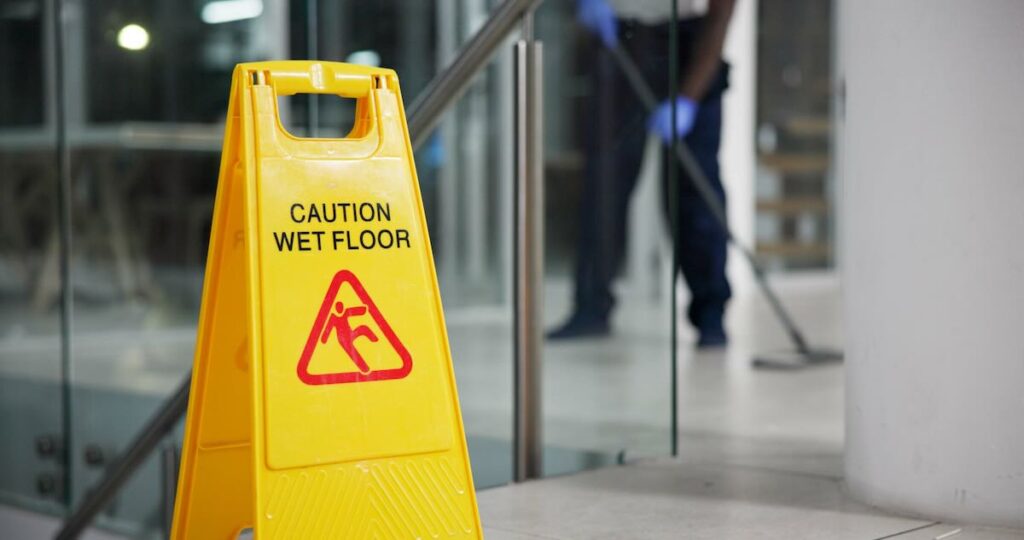Experiencing a slip and fall injury at work can be an overwhelming ordeal. Often underestimated, these incidents can lead to serious, long-term injuries including broken bones, traumatic brain injuries, and spinal issues. They can happen anywhere – from offices with slick surfaces to construction areas cluttered with hazards.
The aftermath of such accidents can be dire, with hefty medical bills, lost earnings, and a profound effect on your future earning capacity. It’s essential to know your rights and the necessary steps to ensure you’re adequately compensated. Workers’ compensation is meant to cover your medical costs and lost wages, yet the claim process is intricate.
This guide aims to navigate you through the critical actions post a workplace slip and fall, ensuring you file a successful workers’ compensation claim to aid in your recovery and financial stability.
Immediate Steps Following a Slip and Fall
Seek Medical Attention
After a slip and fall accident at work, your immediate priority should be to seek medical attention. Even if your injuries seem minor, it is important to get a professional medical evaluation.
Some injuries, such as concussions, internal damage, or spinal injuries, may not be immediately apparent but can lead to severe and long-lasting complications if left untreated. Visiting a doctor right away helps to establish a clear record of your injuries, which is essential for supporting your workers’ compensation claim or any potential personal injury lawsuit.
Report the Incident to Your Employer
Reporting the incident to your employer is a critical step that must be taken as soon as possible. Inform your supervisor or the person in charge of the workplace about the accident, providing them with detailed information about what happened, including the time, location, and any contributing factors such as wet floors, uneven surfaces, or poor lighting.
Request that an official accident report be created and ensure you receive a copy of this report for your records. This documentation is vital as it helps to create a formal record of the incident and can serve as evidence in your workers’ compensation claim or other legal proceedings.
Documenting the Accident for Your Claim
Gather Evidence at the Scene
Documenting the accident scene is a critical step in building a strong workers’ compensation claim or personal injury case.
Immediately after the accident, if you are physically able, take the time to gather as much evidence as possible. This includes taking photos of the area where the slip and fall occurred, capturing any hazardous conditions such as wet floors, uneven surfaces, or poor lighting.
Also, photograph any visible injuries, including bruises, cuts, and other physical damage.
In addition to photos, collect any other relevant evidence from the scene. This can include witness statements, which are invaluable for providing accounts of the accident. Ask witnesses for their contact information and request a detailed statement of what they saw before, during, and after the accident.
Ensure you get their names, phone numbers, and any other contact details.
Other important pieces of evidence include any physical objects or debris that may have contributed to the accident. For example, if you slipped on a spill, try to preserve the area or take photos of the spill before it is cleaned up. If there are any security cameras in the vicinity, note their locations and request the footage from your employer or the relevant authorities.
Maintain Records
Maintaining detailed and comprehensive records is essential for supporting your claim.
Start by keeping a detailed injury diary or journal that documents your injuries, symptoms, treatments, and any follow-up appointments. This journal should include information about the extent of your injuries, the treatment you received, your recovery timeline, and any complications that arose during your recovery.
Ensure you have all medical records and bills related to your injuries.
This includes initial medical examinations, specialist reports, and any ongoing treatment records. Keep track of all correspondence with your medical providers and the insurance company, as well as any communication with your employer regarding the accident and your injuries.
Also, document any impact the injury has had on your daily routine, ability to work, and overall quality of life.
This can include records of lost wages, missed workdays, and any other expenses incurred due to the injury. Keeping a record of these details helps to quantify the damages and ensures you receive fair compensation for your losses.
Navigating the Claims Process
Filing a Workers’ Compensation Claim
First, you must notify your employer about the injury within the specified timeframe, typically within 30 days in many states, such as New York.
After notifying your employer, you will need to complete the appropriate claim form. For example, in New York, you need to fill out the Employee Claim (Form C-3), while in Massachusetts, you would use Form 110 – Employee Claim.
The claim form will require detailed information, including your employer’s name and address, the date and time of the injury, the body parts affected, and the names and addresses of any other employers you were working for at the time of the injury.
You will also need to provide information about your wages and the medical treatment you received.
Once the form is completed, you will need to submit it along with supporting documents such as medical reports, unpaid medical bills, and any witness statements. In some cases, you may need to submit additional forms, such as a Limited Release of Health Information if you have previously injured the same body part or had a similar illness.
The claim should be submitted to the relevant workers’ compensation board or department, and in some cases, a copy must also be sent to your employer’s workers’ compensation insurance carrier by certified mail.
Consulting a Specialized Attorney
Navigating the workers’ compensation claims process can be complex and time-consuming, especially if your claim is denied or if you are facing resistance from your employer or the insurance carrier.
In such cases, consulting a specialized workers’ compensation attorney can be highly beneficial.
A workers’ compensation lawyer can help you understand your rights and ensure that you comply with all the necessary steps and deadlines. They can assist in gathering and submitting the required documentation, communicating with the insurance company, and representing you in any hearings or appeals that may be necessary.
Additionally, a lawyer can help you navigate the nuances of your state’s workers’ compensation laws, which can vary significantly. For instance, they can advise on the types of benefits you are eligible for, such as medical benefits, wage replacement benefits, and travel expenses related to your treatment.
It is also important to note that in many states, the attorney’s fees for a workers’ compensation case are typically paid from your wage replacement awards, meaning you do not have to pay the attorney directly or pay a retainer.
Conclusion
If you have suffered a slip and fall injury at work, it is important to take immediate and thorough action to protect your rights and ensure you receive the compensation you deserve.
Remember to seek medical attention promptly, report the incident to your employer, and gather as much evidence as possible from the scene. Documenting every detail of the accident and maintaining detailed records of your injuries and treatment is vital for a strong workers’ compensation claim.
Consulting a specialized workers’ compensation attorney can also provide invaluable guidance and support throughout the claims process. By following these steps, you can navigate the complex claims process effectively and secure the medical benefits and financial compensation necessary for your recovery.




